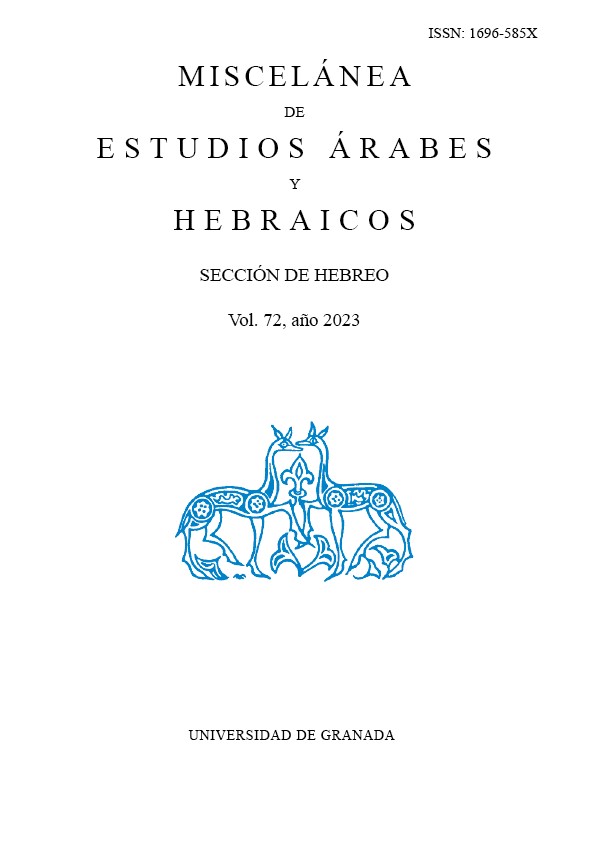Contextos del árabe como segunda lengua en Israel. Estado de la cuestión
DOI:
https://doi.org/10.30827/meahhebreo.v72.28294Palabras clave:
árabe como segunda lengua, Israel, capital lingüístico, motivación, enseñanza de segundas lenguasResumen
Este artículo aborda la docencia del árabe en Israel como segunda lengua. Es decir, se centra en la enseñanza y aprendizaje del árabe dentro del sector demográfico hebreo. Dado el valor sociolingüístico y pedagógico de dicha cuestión, el artículo usa como base metodológica las diferentes disciplinas que conforman el ámbito la lingüística aplicada. Asimismo, y asumiendo la dificultad que supone hacer justicia académica al tan huidizo término de «contexto», se ha decidido apostar por una variedad de enfoques que permita dar cuenta de un fenómeno necesariamente complejo, con manifestaciones y causas que descansan en más de un dominio del saber. Comenzamos por analizar la situación lingüística de Israel, abarcando tanto la separación jerárquica hebreo-árabe como su explicación social y económica. Tras ello repasamos las políticas lingüísticas relativas al papel del árabe emanadas, principalmente, de los organismos oficiales, con especial énfasis en las políticas educativas. Finalmente, observamos las manifestaciones pedagógicas concretas. Para ello abordamos el fenómeno desde tres perspectivas: la metodología docente, las actitudes del alumnado y los resultados del aprendizaje. Las causas de este fracaso educativo, concluye el artículo, se hallan repartidas en dichos ámbitos de actuación lingüística: la sociedad, la política y las aulas.
Descargas
Citas
Amara, Muhammad Hasan (2006), Teaching Arabic in Israel. En Wahba, K.M. (Ed.), Handbook for Arabic Language Teaching Professionals in the 21st Century. Mahwah: Lawrence Erlbaum Associates: 92-95.
Amara, Muhammad Hasan (2002), The place of Arabic in Israel. International Journal of the Sociology of Language, 158: 53-68. https://www.degruyter.com/document/doi/10.1515/ijsl.2002.051/html (consultado el 22-10-2021).
Brosh, Hezi (1993) The Influence of Language Status on Language Acquisition: Arabic in the Israeli Setting. Foreign Language Annals, 26. 3: 347-358. https://www.proquest.com/docview/1311708614/fulltextPDF/7344BABD99D74C56PQ/7?accountid=14542 (consultado el 19-02-22).
Brosh, Hezi (1997) The Sociocultural Message of Language Textbooks: Arabic in the Israel Setting. Foreign Language Annals, 30. 3: 311-326. https://onlinelibrary.wiley.com/doi/epdf/10.1111/j.1944-9720.1997.tb02354.x (consultado el 05-04-22).
Carro Suárez, Manuel F. (1989). Enfoque, método y técnicas en la enseñanza de idiomas: actualización de definiciones. Tavira: Revista de ciencias de la educación, 6: 79-84.
Donitsa-Schmidt, Smada - Inbar, Ofra - Shohamy, Elana (2004), The Effects of Teaching Spoken Arabic on Students’ Attitudes and Motivation in Israel. The Modern Language Journal, 88.2: 217–28. http://www.jstor.org/stable/3588752 [consultado el 22-10-21].
Fragman, Alon - Mor-Sommerfeld, Aura (2021), Bridge over Troubled Water: Spelling Accuracy of Novel Phonemes in Arabic Among Native Hebrew/Speaking Pupils in a Bilingual/Arabic-Hebrew/Elementary School. Yod, 23: 223–245. https://journals.openedition.org/yod/5253 (consultado el 22-10-21).
Fragman, Alon - Russak, Susie (2009), A Qualitative Analysis of Spelling Errors in Arabic as a Foreign language Among Native Hebrew Speaking Students. En Aguilar, V. – Pérez Cañada, L.M. – Santillán Grimm, P. (Eds.), Arabele 2009: Enseñanza y aprendizaje de la lengua árabe. Murcia: Universidad de Murcia: 103-115.
Gardner, Robert C. (2007), Motivation and Second Language Acquisition. Porta Linguarum, 8: 9-20. https://digibug.ugr.es/bitstream/handle/10481/31616/Gardner.pdf?sequence=1&isAllowed=y (consultado el 23-01-2022).
Gardner, Robert C. (1985), Social psychology and second language learning: The role of attitudes and motivation. London: Edward Arnold Publications.
Halperin, Liora R. (2006), Orienting Language: Reflections on the Study of Arabic in the Yishuv. The Jewish Quarterly Review, 96. 4: 481-489. https://web.p.ebscohost.com/ehost/pdfviewer/pdfviewer?vid=3&sid=943def14-40f1-4663-baa4-6a35e2ae3f6c%40redis (consultado el 02-11-21).
Lustigman, Ran (2008), Horaˀat ha-safa ha-ˁaravit be-batey sefer ˁivriyim. Šqiˁa nuga». Kenes Mandel le-ḥinuḵ, 60 šnot ḥinuḵ be-Israel - ˁavar, hove, ˁatid. Jerusalén: Instituto Mandel para el Liderazgo. https://learningarabicoranit.files.wordpress.com/2012/08/d79ed790d79ed7a8-d794d795d7a8d790d7aa-d794d7a9d7a4d794-d794d7a2d7a8d791d799d7aa-d791d791d7aad799-d7a1d7a4d7a8-d7a2d791d7a8d799d799d79d.pdf (consultado el 03-03-2022).
Mendel, Yonatan (2023), Ha-Laṭinit šel ha-Mizraḥ ha-tiḵon. Tel-Aviv: Hakibbutz Hameuchad Publishing House.
Pastor Cesteros, Susana (2004), Aprendizaje de segundas lenguas: lingüística aplicada a la enseñanza de idiomas. Alicante: Universidad de Alicante.
Rai, Gili (2018), Im maˁareḵet ha-ḥinuḵ haita roṣa, ze haya qore». Haaretz. https://www.haaretz.co.il/opinions/1.6243887. (consultado el 23-06-22).
Russak, Susie - Fragman, Alon (2014), Spelling Development in Arabic as a Foreign Language Among Native Hebrew Speaking Pupils. Reading & writing, 27. 2: 359–381. https://www.proquest.com/docview/1476476310/fulltextPDF/9AB54933F5C14E65PQ/1?accountid=14542 (consultado el 30-03-22).
Spolsky, Bernard (2008), Language Policy. Cambridge: Cambridge University Press.
Spolsky, Bernard (1994), The situation of Arabic in Israel. En Suleiman, Y. (Ed.), Arabic Sociolinguistics: Issues & Perspectives. Richmond: Curzon Press: 227-237.
Suleiman, Yasir (2006), Charting the Nation: Arabic and the Politics of Identity. Annual Review of Applied Linguistics, 26: 125-48.
Uhlmann, Allon J. (2010), Arabic Instruction in Jewish Schools and in Universities in Israel: Contradictions, Subversion and the Politics of Pedagogy. International Journal of Middle East Studies, 42. 4: 291-309. https://www.jstor.org/stable/pdf/40784727.pdf?refreqid=excelsior%3A59e40aab066845fa8e56e7f834b8ca61 (consultado el 23-10-21).
Uhlmann, Allon J. (2022), Military intelligence and the securitization of Arabic proficiency in Israel: the limits of influence and the curse of unintended consequences. Intelligence and National Security, 37. 4: 541-555. https://www.researchgate.net/publication/360104285_Military_intelligence_and_the_securitization_of_Arabic_proficiency_in_Israel_the_limits_of_influence_and_the_curse_of_unintended_consequences (consultado el 04-08-23).
Utma, Ragda (2022), «Iqbāl fī Israˀīl ˁalà taˁallum al-luga al-ˁarabiyya li-dawāfiˁ amaniyya wa-iqtiṣādiyya». Independent Arabia.
Publicado
Cómo citar
Número
Sección
Licencia
Derechos de autor 2023 Adrián Téllez Martín

Esta obra está bajo una licencia internacional Creative Commons Atribución-NoComercial 4.0.

Este obra está bajo una licencia de Creative Commons Reconocimiento-NoComercial 4.0 Internacional.












